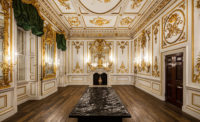Designed to house 111,111 people in a checkerboard of 69-story buildings stacked on top of each other, the Permeable Lattice City takes the notion of high-density urbanism to an extreme. Its staggered arrangement of building blocks brings light and air to all parts of the complex, while providing spaces for sky gardens and communal facilities connected vertically by multi-cabin elevators and people movers. Imagine a city grid turned vertical and you get an idea of what Wong Mun Summ and Richard Hassell, the partners of the Singapore-based firm WOHA, have in mind with this XXL-size project, which they developed as a research tool.
In recent decades, Southeast Asia has become a vibrant laboratory of high-density urbanism with places such as Singapore, Bangkok, and Hong Kong packing more people into taller buildings on smaller parcels of land. If built, the Permeable Lattice City would provide 17 square kilometers of gross floor area on a site that is just 1 square kilometer. Garden City Mega City, an exhibition that opened on March 23 at the Skyscraper Museum in Manhattan and runs through September 4, looks at 12 high-rise projects by WOHA and challenges Americans’ ideas of what it means to live in close quarters.
In completed projects like the Met in Bangkok and SkyVille@Dawson in Singapore, WOHA has demonstrated it can create high-density complexes where breezeways and a rich variety of outdoor spaces—both at ground level and above—subvert the 20th-century model of hermetically sealed buildings continually pumped with air-conditioning. As seen in all of the projects in this exhibition, Wong and Hassell love to carve out spaces in their buildings for residents to enjoy the outdoors, in the process encouraging the kind of intense communal life that has traditionally made Asian cities so vibrant. The goal is to design housing complexes that are “woven together socially by layers of parks and gardens,” says Wong.
While the early Modernists brought a seriousness of purpose to high-density housing that often made it dry and clinical, WOHA designs with exuberance—using snaking balconies and colorful panels to give life to their buildings no matter how big. The installation at the Skyscraper Museum underscores the lush and energetic nature of the work. Beautiful, plexiglass models—one for each project—help visitors understand the formal complexities of the buildings, and recent drone videos add a cinematic quality to the exhibition. Sometimes, though, it’s hard to tell if the footage is real or computer generated, which injects a surreal note to an architecture that is already a bit wild by American standards.
Drone footage of PARKROYAL on Pickering.
Text panels at the start of the exhibit talk a bit about mega-cities in Asia, but it would have been helpful to see some photographs of key projects in these places. One panel acknowledges the influence on WOHA of Paul Rudolph’s innovative towers in Asia, such as the Concourse in Singapore. But showing a few works by Ken Yeang, Soo Chan, and other architects doing high-rise projects in this part of the world would have provided a better context for WOHA’s accomplishments.
Visitors to the show may also wonder if WOHA’s ideas are transferable to cities in North America or Europe. “In New York, we’re looking to develop projects with smaller living unites and higher densities,” says Carol Willis, director of the Skyscraper Museum. “WOHA has done this and made it attractive by adding amenities such as gardens and social spaces,” she adds. Changes would need to be made to accommodate cities in more temperate climates, where shade—for example—isn’t as welcome as it is in Southeast Asia, admits Wong. But the bigger message of designing for much higher densities is applicable to other parts of the world, he states. “Our cities are based on 20th-century ideas and geared to the automobile,” says Wong. “We need to turn horizontal cities into vertical ones.”
















Post a comment to this article
Report Abusive Comment